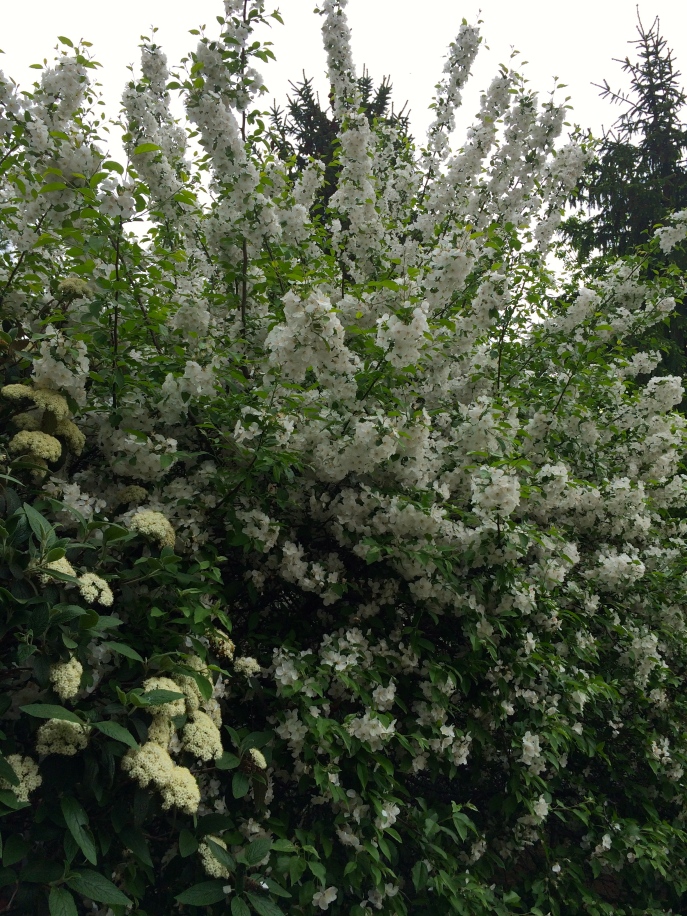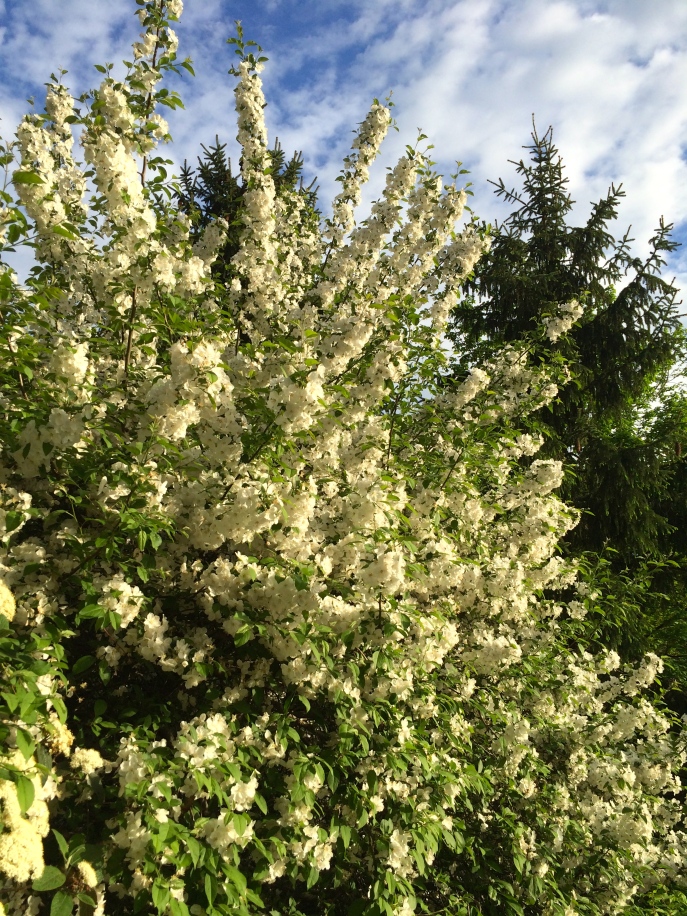We’ve lived at our present address since 2006 and have generally appreciated the grounds that “come” with our condo, but after eighty-plus years in cities, our horticultural know-how is pretty much nil. I can identify daffodils and tulips outside, roses, orchids, sunflowers and lilies inside — but that’s about it. And during the time he still maintained a part-time practice in Princeton, Bill didn’t seem particularly curious about nature, either.
Until with time on his finally retired hands, he developed a new thirst for learning what was what. Now he’s always exclaiming about the beauty of this or that, and asking the names of growing things. Looking out our bedroom window when we wake up, I scan the sky for the weather, he scans the trees.
So it is that whereas I consider the tree directly in front of the building just a tree and don’t ponder further, he has begun gazing lovingly at it first thing every day, especially since its branches developed white flowers a week ago. “Look, look!” he urged this morning.

The tree we’re talking about is the one on the right. (Not the one with creamy parasol-shaped “flowers” at the lower left.)
“Mmm, lovely,” I agreed, heading for the bathroom.
“Take a picture,” he demanded.
“Now, in my nightgown? It’s cloudy out today. It wouldn’t be a good picture, anyway.”
“Well not now this minute,” he said. “After breakfast. Before the flowers are gone. The petals are already beginning to fall.”
And that was true. When I looked down at the walkway, it was already covered with a blanket of fallen white petals. So I took pictures. Even though it was cloudy. Enough pictures to satisfy the most demanding of men.
The most demanding of men was happy for about two minutes. “Great pictures,” he said. “I wonder what kind of tree it is.”
He was asking me?
We referred the question to Google. Could Google identify a briefly white-flowering tree native to New Jersey? Google knew too much. It told us (with pictures) that “our” tree might be a Cleveland Pear (because the leaves of that tree, like ours, turn red in the fall) or a Natchez Crepe (because the blossoms look like our blossoms). But the Natchez is described as blooming for 110 days a year, which is definitely not the case chez nous. And the Cleveland Pear is not described as having a very short blooming season. Moreover, our tree does not produce pears, not even small misshapen ones. And that was just the first page.
“Why don’t we ask my blog readers?” I suggested. “Many seem to have comprehensive knowledge of plant life. Someone is sure to know.”
Bill thought that might be a good idea. Hence this post.
Then the sun came out. Which may make determining what kind of tree we have an easier question to answer. Or perhaps not. It does make the flowers prettier to look at.

You may have already noticed: when I begin doing something, I find it hard to stop. If it’s not too many words, it’s too many pictures. (But how do I choose which to keep and which to toss?)
Look all you like. And if you know what you’re looking at — meaning what in the world is the name of this tree — please tell. Bill would love to know too.








A beautiful post and a beautiful tree! And if you never find out what kind of tree it is, just know that it’s beautiful. In the end, that’s all that matters.
LikeLiked by 1 person
And a beautiful comment as well, JC!
LikeLike
Nina, don’t disparage photography in cloudy weather: it is often, if not always, the best for true color reproduction and clarity. I prefer your Mystery Shrub, or Tree, in those first pictures (first of a multitude!). I guess photography in one’s night clothes is dicey in the burbs. Here in rural Maryland one can not only photograph fields and gardens in the early morning light but start digging in said clothes before breakfast. I’ve got a washerload of clay-stained nightshirts my husband has learned not to question when I roll into bed with him.
A garden designer and grower/propagator of plants native to the mid-Atlantic, I can’t identify yours. It looks strangely familiar but unnameable, like a hybrid of some Korean or Japanese dogwood (Cornus spp) and upright Spirea. Short bloom season, red leaves in fall… More details needed.
Please assure Bill that he’s not alone in yearning to know the identities of these beauties, ephemeral and long-blooming and everything in-between. I long to know my plants intimately.
A floriferous spring to both of you!
LikeLiked by 1 person
Thank you so much, Judith, for your friendly and informative comment. (I too would love to run around all day in my nightclothes if that were feasible in rather proper Princeton.) I’m sure our tree is not a dogwood. Based on other comments, both online and in email, I’m inclined to think ours is a variety of pear tree after all. But, as JC observed, perhaps it doesn’t matter so much what it is (if one is not a garden designer and grower/propagator of plants like yourself)…as long as it’s beautiful. And a floriferous spring to you, as well!
LikeLike
Oh, I certainly wouldn’t confuse your specimen for a dogwood, Nina, except for the dogwoodlike blossoms—dogwoodlike on my iPad screen at any rate. I know better than that! And I wouldn’t confuse it for a Spirea either. I only meant that it has similarities to well-known species used in many gardens but seems unidentifiable, a strange cross between two disparate species. The density of the blossoms loading those branches: what profusion! I guess ornamental pears, that put out no effort into producing fruit and that enjoy regular pruning (yes, by someone?), can afford to load up on blossoms. Just for the pure joy of it.
My grandfather and uncle were orchardists, and as a girl and teenager I helped sell the fruit in the summertime. So my bias may be toward fruiting trees, no plain janes themselves but never the runway models.
LikeLiked by 1 person
To me, Judith, you are the Einstein of horticulturists — at least among those who visit this blog — and I in no way meant to impugn your expertise. Yes, our trees get regular pruning by the company hired by the condo association (with part of the money we all pay in on a quarterly basis). “Blossoms for the pure joy of it.” I love that!
LikeLike
It could be a decorative pear tree. There are several different cultivars (we have an Aristocrat Pear) and they don’t necessarily produce fruit. The blossoms don’t usually smell great. I have a crabapple that blooms white with the same outline but the flowers are wonderfully scented. Doesn’t look like a dogwood to me and it’s shape isn’t quite right for spirea. If you find out, please blog again.
LikeLiked by 1 person
I will indeed let you know if I ever find out anything definitive. For now, I’m inclined to go with your hypothesis, because it’s corroborated by a couple of comments I received in email from email readers: it’s probably a decorative pear tree of some kind. (I just k-n-e-w you’d have something helpful to say about this! :-))
LikeLiked by 1 person
Well, it is not a tulip nor a daffodil tree. It is a beautiflu tree. I am pretty sure of that. Yes, I am sure, I looked again! It is a beautiful tree.
LikeLiked by 1 person
Agreed, Gerard!
LikeLike
The blossoms make it look like an ornamental pear tree variety..but it has such a different shape. So, maybe not. Whatever it is, enjoy it. It is beautiful and the blossoms never last long. ☺ Van
LikeLike
Another knowledgeable reader! By now, I’m inclined to believe it’s a variety of ornamental pear tree, too. (See my response to Kate Crimmins above.) It’s true: one must enjoy whatever there is to enjoy while it’s here, including flowers on a briefly flowering tree, because it never lasts long. A bittersweet sort of reply to your comment. (But unfortunately true.)
LikeLiked by 1 person
Van… what about the one on the left? Lace-cap hydrangea or too early for Princeton?
LikeLiked by 2 people
Not sure, we had a great Spring on the east coast, and it got really warm in the past few weeks. Maybe ??
LikeLiked by 2 people
Beautiful tree! I have no idea, but I am always searching for names for trees. Then I forget them later on . . . .
LikeLike
I wouldn’t know about your local trees and shrubs and cannot see the detail of the blossom and leaves, but the nearest in general appearance of shrubs here in the UK would be a Philadelphus. I’ve just looked it up, it is a North American native. There are many varieties of this and a lot of them are sweetly scented.
LikeLiked by 1 person
No idea what it is, but it is beautiful. Identifying plants, though, makes me think I should tell you about a flower here called (and I can’t remember what it looks like, so I’d have to ask, leading to all the confusion you’ll understand when you get to the next phrase) Mind Your Own Business.
LikeLiked by 1 person
An apt thought. But a flower called “Mind Your Own Business?” Can I quote you on that?
LikeLike
Absolutely. I seem to have lied about if being a flower, though; it looks flowerless here: https://www.rhs.org.uk/advice/profile?pid=348
LikeLike
“A creeping perennial also known as ‘Baby’s tears.” Baby tears I’ve heard of. Also (I think) seen. Now I can rest easy again. 🙂
LikeLike